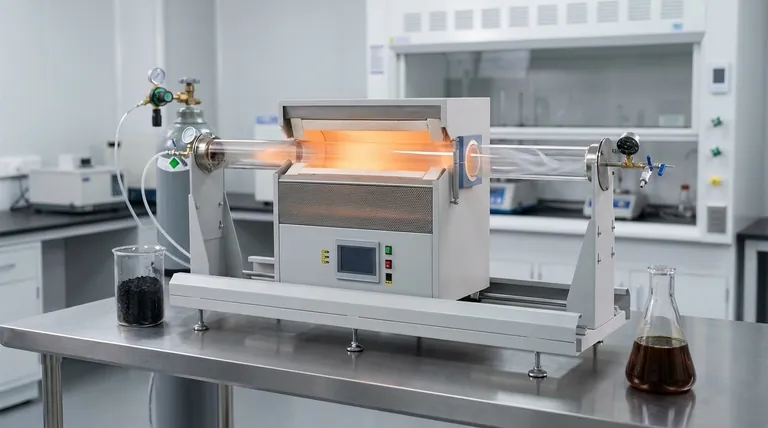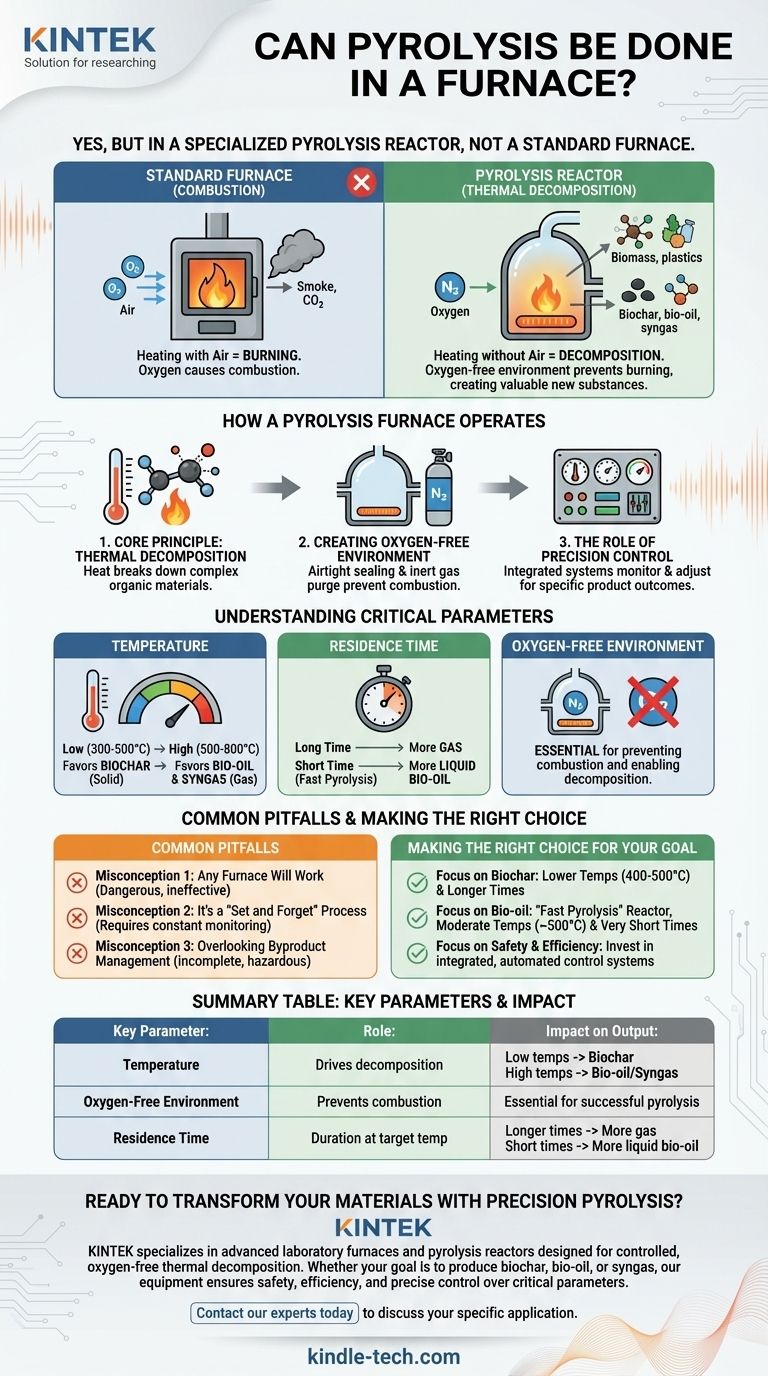네, 열분해는 근본적으로 용광로 기반 공정입니다. 하지만 아무 용광로에서나 수행되는 것은 아닙니다. 연소 대신 열분해를 유발하기 위해 유기 물질을 통제된 무산소 환경에서 매우 높은 온도로 가열하도록 설계된 특수 밀폐 챔버가 필요합니다.
표준 용광로는 공기 존재 하에 가열하도록 설계되어 연소를 유발합니다. 열분해 용광로(더 정확하게는 열분해 반응기)는 산소를 제거하여 연소를 방지하고, 이를 통해 물질을 가치 있는 새로운 물질로 분해하도록 설계된 고도로 제어되는 시스템입니다.
열분해 용광로 작동 방식
열분해 용광로는 특정 화학적 변환을 위해 설계된 시스템의 핵심입니다. 그 작동은 반응 환경에 대한 정밀한 제어에 달려 있습니다.
핵심 원리: 열분해
열분해는 바이오매스나 플라스틱과 같은 복잡한 유기 물질을 열을 사용하여 분해하는 과정입니다. 산소와의 화학 반응인 연소와 달리, 열분해는 열적 분해입니다.
용광로의 발열체는 챔버 내부의 물질 온도를 분자 내의 화학 결합이 불안정해지고 분리되는 지점까지 높입니다.
무산소 환경 조성
이것은 열분해 용광로를 표준 용광로와 구별하는 가장 중요한 단일 요소입니다. 물질이 단순히 불이 붙는 것(연소)을 방지하기 위해 산소가 없어야 합니다.
이를 위해 용광로 챔버는 기밀하게 밀봉됩니다. 가열을 시작하기 전에 시스템에서 산소를 제거하고 질소와 같은 불활성 가스로 대체하는 경우가 많습니다. 이는 열만이 물질에 작용하도록 보장합니다.
정밀 제어의 역할
용광로는 단순한 뜨거운 상자가 아닙니다. 통합 시스템입니다. 정교한 제어 장치는 공정의 결과를 결정하기 위해 주요 매개변수를 지속적으로 모니터링하고 조정합니다. 최종 제품(가스, 액체 또는 고체)은 이러한 설정에 전적으로 달려 있습니다.

주요 매개변수 이해
열분해의 효율성과 생성되는 특정 제품은 세 가지 주요 변수에 의해 결정됩니다. 원하는 결과를 얻기 위해서는 이들을 제어하는 것이 필수적입니다.
온도
온도는 반응의 주요 동인입니다. 다른 온도 범위는 다른 제품에 유리합니다.
- 저온 (300-500°C): 저온에서 더 느린 가열은 바이오차로 알려진 고체 잔류물의 수율을 최대화하는 경향이 있습니다.
- 고온 (500-800°C): 고온에서 더 빠른 가열은 액체(바이오 오일) 및 가연성 가스(합성 가스) 생산에 유리합니다.
체류 시간
이는 물질이 용광로 내부의 목표 온도에서 유지되는 시간을 나타냅니다. 체류 시간이 길수록 열분해가 더 진행되어 더 큰 분자가 더 작은 분자로 분해됩니다.
시간이 길어지면 가스 생산이 증가할 수 있으며, 매우 짧은 체류 시간은 액체 바이오 오일 수율을 최대화하기 위해 "고속 열분해"에 자주 사용됩니다.
압력 및 모니터링
온도와 시간은 주요 요소이지만, 밀폐된 용광로 내의 압력도 안전과 공정 안정성을 위해 관리되어야 합니다. 통합 제어 루프는 이러한 조건을 모니터링하여 위험한 축적을 방지하고 반응이 계획대로 진행되도록 합니다. 최신 시스템은 예측 모델을 사용하여 문제가 발생하기 전에 예측하고 수정합니다.
피해야 할 일반적인 함정
단순한 히터와 열분해 반응기의 차이를 이해하는 것은 안전과 성공에 매우 중요합니다.
오해 1: 어떤 용광로든 작동할 것이다
표준 산업 용광로 또는 가마는 공기 존재 하에 발생하는 공정을 위해 설계되었습니다. 광범위한 수정 없이 열분해에 사용하는 것은 비효율적이고 극도로 위험합니다. 생성된 뜨거운 가스는 가연성이며 산소가 있으면 발화할 수 있기 때문입니다.
오해 2: "설정하고 잊어버리는" 공정이다
열분해는 동적인 공정입니다. 공급원료의 구성과 반응의 진행은 지속적인 모니터링과 조정이 필요합니다. 안전한 작동은 신뢰할 수 있는 제어 시스템과 산업 환경에서는 안정성을 유지하기 위한 스마트 기술에 달려 있습니다.
오해 3: 부산물 관리 간과
이 공정은 고체, 액체, 가스의 혼합물을 생성합니다. 완전한 열분해 시스템에는 이러한 결과물을 안전하게 수집, 냉각 및 분리하는 장비가 포함됩니다. 이러한 후방 인프라 없이 밀폐된 드럼에서 단순히 물질을 가열하는 것은 불완전하고 위험한 접근 방식입니다.
목표에 맞는 올바른 선택
열분해 용광로의 설계 및 작동은 의도된 제품에 따라 결정됩니다.
- 농업용 바이오차 생산이 주요 목표인 경우: 고체 생산량을 최대화하기 위해 저온(약 400-500°C) 및 긴 체류 시간에 최적화된 시스템이 필요합니다.
- 액체 연료로서 바이오 오일 생성이 주요 목표인 경우: 중간 온도(약 500°C)로 빠르게 가열하고 매우 짧은 체류 시간을 갖도록 설계된 "고속 열분해" 반응기가 필요합니다.
- 산업 안전 및 효율성이 주요 목표인 경우: 온도, 압력 및 공급원료 흐름을 정밀하게 관리하기 위한 통합 자동 제어 루프가 있는 용광로에 투자해야 합니다.
정밀하게 용광로 환경을 제어함으로써 단순한 가열 공정을 정교한 화학 제조 방법으로 전환할 수 있습니다.
요약표:
| 주요 매개변수 | 열분해에서의 역할 | 생산물에 미치는 영향 |
|---|---|---|
| 온도 | 열분해 반응을 유도합니다. | 저온 (300-500°C)은 바이오차에 유리하고; 고온 (500-800°C)은 바이오 오일/합성 가스에 유리합니다. |
| 무산소 환경 | 연소를 방지하고 분해를 가능하게 합니다. | 성공적인 열분해에 필수적이며; 산소의 부재가 중요합니다. |
| 체류 시간 | 물질이 목표 온도에서 유지되는 시간입니다. | 시간이 길어지면 가스 수율이 증가하고; 시간이 짧으면 액체 바이오 오일이 최대화됩니다. |
정밀 열분해로 재료를 변환할 준비가 되셨습니까?
KINTEK은 제어된 무산소 열분해를 위해 설계된 고급 실험실 용광로 및 열분해 반응기를 전문으로 합니다. 바이오차, 바이오 오일 또는 합성 가스 생산이 목표이든, 당사의 장비는 안전, 효율성 및 주요 매개변수에 대한 정밀한 제어를 보장합니다.
오늘 저희 전문가에게 문의하여 귀하의 특정 응용 분야에 대해 논의하고 귀하의 실험실에 적합한 열분해 솔루션을 찾아보십시오.
시각적 가이드

관련 제품
- 실험실 석영 튜브로 RTP 가열로
- 실험실 탈바가지 및 소결 전 가열로
- 알루미나 튜브가 있는 1700℃ 실험실 석영 튜브 퍼니스 튜브 퍼니스
- 수직 실험실 석영 튜브 퍼니스 튜브형 퍼니스
- 1400℃ 실험실용 알루미나 튜브 머플로



















